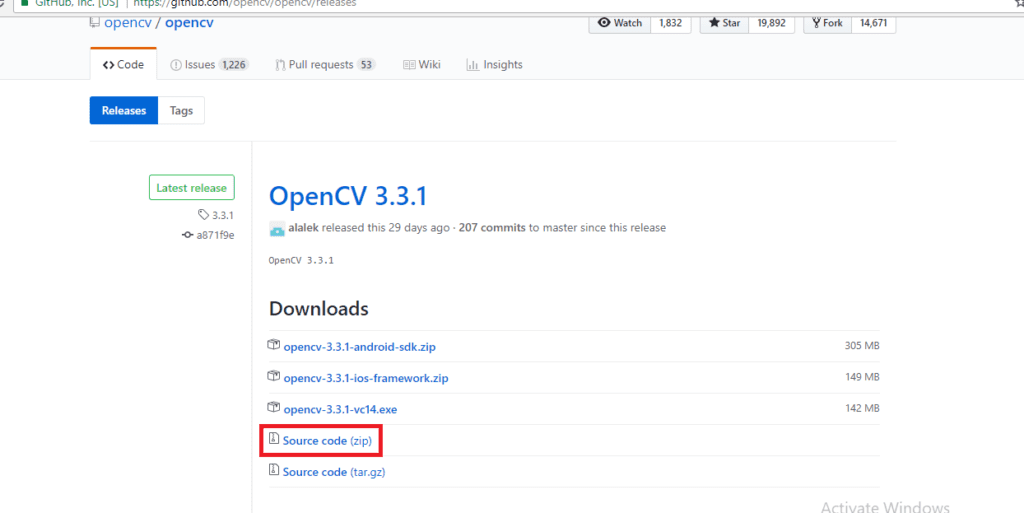
- #Install video reader opencv for mac how to
- #Install video reader opencv for mac code
- #Install video reader opencv for mac windows
#Install video reader opencv for mac code
OptionĮnable profiling compiler and linker options.Įnable several quirks in code to assist memory sanitizer.Įnable compiler options which reduce possibility of code exploitation.Įnable thin LTO which incorporates intermediate bitcode to binaries allowing consumers optimize their applications later. Profiling, coverage, sanitize, hardening, size optimizationįollowing options can be used to produce special builds with instrumentation or improved security. opencv Note More details on CPU optimization options can be found in wiki: That’s all folks! Let me know in the comments section if you face any issues.Cmake -DCV_DISABLE_OPTIMIZATION=ON. The moment you quit the output video, the video is saved in the path specified until the point where the output was streamed. The video is being written in the background at the speed at which you are shown the video.

Once you run the code through the Anaconda prompt, you will see the pop-up video which displays the output in frames. To generate a colored video as output, we use the isColor parameter. However, you can get the input video’s frame dimensions using: frame_width = int(cap.get(3)) frame_height = int(cap.get(4))įrames per second can be mapped to the input video’s FPS value using: get(CAP_PROP_FPS) or get(CV_CAP_PROP_FPS) Please note that you need to write the codec in lowercaseĪlso, the frame width and frame height can be referenced to the input video/webcam or the user provides it. We can define it as follows: fourcc = cv2.VideoWriter_fourcc('m','p','4','v')# note the lower case The output of the written video needs specifications like filename, codec, frames per second (fps), frame height and frame width.įourcc: Codec which needs to be stated. The code which saves the output video in the specified path is below with changes in bold with reference to the code shown above - explanation follows after the code import cv2 cap = cv2.VideoCapture( ) fourcc = cv2.VideoWriter_fourcc('m','p','4','v')# note the lower case frame_width = int(cap.get(3)) frame_height = int(cap.get(4)) out = cv2.VideoWriter(,fourcc, 10, (frame_width,frame_height), True) pd_cascade = cv2.CascadeClassifier( ) while True: ret, frames = cap.read() pedestrians = pd_tectMultiScale( frames, 1.1, 1) for (x,y,w,h) in pedestrians: cv2.rectangle(frames,(x,y),(x+w,y+h),(0,255,0),2) font = cv2.FONT_HERSHEY_DUPLEX cv2.putText(frames, 'Person', (x + 6, y - 6), font, 0.5, (0, 255, 0), 1) cv2.imshow('Pedestrian detection', frames) out.write(frames) if cv2.waitKey(33) = 13: break cap.release() out.release() cv2.destroyAllWindows() Explanation of the codeīefore we start reading the video in frames, we define the output as follows: fourcc = cv2.VideoWriter_fourcc('m','p','4','v')# note the lower case frame_width = int(cap.get(3)) frame_height = int(cap.get(4)) out = cv2.VideoWriter(,fourcc, 10, (frame_width,frame_height), True) Code to write the video on the hard drive - macOS To record the content which is shown in individual frames to the user through the imshow command, we need to define the output where each frame in the while loop is written over the output. import cv2 cap = cv2.VideoCapture( ) pedestrian_cascade = cv2.CascadeClassifier(cv2.VideoCapture( )) while True: ret, frames = cap.read() pedestrians = pedestrian_tectMultiScale( frames, 1.1, 1) for (x,y,w,h) in pedestrians: cv2.rectangle(frames,(x,y),(x+w,y+h),(0,255,0),2) font = cv2.FONT_HERSHEY_DUPLEX cv2.putText(frames, 'Person', (x + 6, y - 6), font, 0.5, (0, 255, 0), 1) cv2.imshow('Pedestrian detection', frames) if cv2.waitKey(33) = 13: break cap.release() cv2.destroyAllWindows() Let us take the pedestrian detection code as a reference. The issue is with the output codec, and the CV community often discusses it.
#Install video reader opencv for mac windows
Tip: Saving the video in a windows system is a painful task.


#Install video reader opencv for mac how to
In this article, we will learn how to save the output video in macOS system.

I realized that there are very few articles which explain the exact way on how to do it. I did some research on the process of saving the output of object detection on OpenCV in Python in a video format on the hard drive. This post is important to those of you who have successfully worked on your object detection task.


 0 kommentar(er)
0 kommentar(er)
